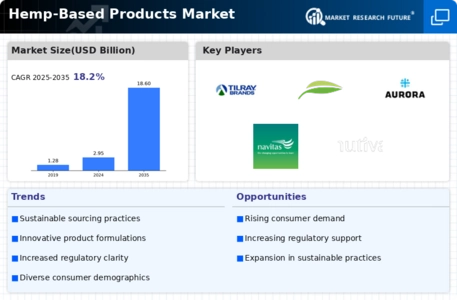Market Trends
Introduction
The market for hemp-based products is undergoing a major transformation as we enter 2024, a transformation that is being driven by a confluence of macro-factors. The evolution of extraction and processing methods is enhancing the quality of the products and the scope of their applications, while the evolution of the regulatory framework is opening up new opportunities for market entry and innovation. Moreover, the evolution of consumer behaviour, in which a greater preference is being expressed for natural and sustainable products, is reshaping the demand curve. These trends are strategically important for the industry’s key players, as they influence not only product development and marketing strategies, but also the positioning of their companies in an increasingly crowded marketplace.
Top Trends
-
Sustainable Packaging Innovations
Hemp is becoming increasingly important in the packaging of hemp products. This is because of the growing demand for eco-friendly products from consumers. According to a survey, about 70 percent of consumers prefer sustainable packaging. Hemp Foods Australia is a pioneer in this field. The company is not only strengthening its brand loyalty, but also contributing to the world's sustainable development goals, which may eventually lead to changes in packaging regulations. -
Expansion of Hemp-Based Food Products
Hemp-based food products are gaining ground, especially hemp seed and hemp oil. Nutiva, the industry leader, reports a 30% increase in the sale of hemp foods, indicating the growing interest in plant-based diets. This trend will certainly encourage more food manufacturers to experiment with hemp as an ingredient. Moreover, it will have a repercussion on dietary guidelines and food regulations. -
Increased Focus on CBD and Wellness Products
The health industry is experiencing a boom in hemp-derived CBD products. And companies like Tilray are expanding their product lines. In the meantime, as more and more people are interested in the health benefits of CBD, regulators are responding by drawing up more precise guidelines. This is expected to lead to innovation in product formulation and possibly to more comprehensive health claims in marketing. -
Hemp in Textile and Fashion Industries
Hemp is gaining ground in the fashion industry, and brands are increasingly using hemp fibers for sustainable clothing. Reports have shown that the water footprint of hemp fibers can be reduced by up to 50% compared to cotton. This trend is likely to influence fashion regulations and the behavior of eco-conscious consumers, and could result in a broader acceptance of hemp in the mainstream fashion industry. -
Technological Advancements in Hemp Cultivation
The development of agricultural science and technology has made the efficiency of hemp production higher. The big players have already adopted the technique of "precision farming." These techniques can increase the yield by 20 percent, which makes hemp production more profitable. This will lead to more agricultural technology and equipment investment, which will also change the farming methods of hemp farmers. -
Regulatory Developments and Compliance
Growing hemp market, product quality and safety are regulated. Governments are introducing stricter control measures, and 80% of industry leaders want clearer regulations. This trend could affect the cost of doing business and could lead to a more standardized market, thereby enhancing consumers' trust and security. -
Hemp-Based Personal Care Products
Similarly, cosmetics are increasingly using hemp-derived ingredients. Research indicates that 55 per cent of consumers are willing to pay more for natural products. This is driving innovation and is expected to result in a shift in consumers’ preferences towards natural personal care solutions. -
Hemp as a Biofuel Source
Hemp is being explored as a source of sustainable biofuels. Research shows that hemp biodiesel can reduce greenhouse gas emissions by up to 50%. Leading companies are investing in biofuel technology, which could increase our energy independence. This development could change our energy policies and increase the use of renewable resources in the energy sector. -
Hemp in Construction Materials
The building trades are beginning to make use of hemp-lime and hempcrete for the construction of houses. The hempcrete has been found, by research, to reduce the carbon footprint of a building by sequestering carbon dioxide. This new development will no doubt influence building regulations and will encourage the use of green building materials. -
Consumer Education and Awareness Campaigns
It is now a matter of educating the consumers to the benefits of hemp. The studies show that 75% of consumers are unaware of the advantages of hemp. This has led to the decision to inform the public. This trend will contribute to market growth and may lead to a higher demand for hemp products in different industries.
Conclusion: Navigating the Hemp Market Landscape
Competition is becoming more and more fragmented in the hemp-based products market. The old and new players are fighting for market share. The trends in regional markets are growing in favor of hemp products. Especially in North America and Europe, these trends have strategic significance for the industry. The old players are able to rely on their distribution networks and brand names, while the newcomers are relying on innovation and niche markets. The winners will be the ones who are able to master the underlying capabilities of artificial intelligence for consumer insights, automation for efficient production, sustainable sourcing and product diversity. And of course, the suppliers must be able to meet the needs of consumers and navigate the complex regulatory environment.









Leave a Comment